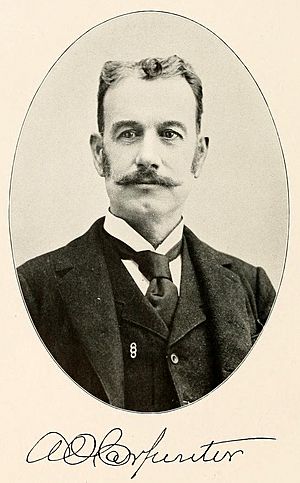Aurelius O. Carpenter facts for kids
Quick facts for kids
A. O. Carpenter
|
|
|---|---|
| Aurelius Ormando Carpenter | |
 |
|
| Born | 1836 |
| Died | 1919 (aged 82–83) United States
|
| Resting place | Ukiah Cemetery, Ukiah, California |
| Nationality | American |
| Known for | Photography of early Mendocino County, California |
| Spouse(s) | Helen McCowan |
A. O. Carpenter (born Aurelius O. Carpenter) was an American photographer, writer, and abolitionist. An abolitionist was someone who wanted to end slavery. He lived from 1836 to 1919.
Carpenter was one of the first photographers in early American California. He took many pictures of Mendocino County, California. He was the son of Clarina I. H. Nichols and the father of famous artist Grace Carpenter Hudson. Before moving to California, he was active in the movement to end slavery. He even joined John Brown in the Battle of Black Jack.
Contents
Life Story
Early Years in Vermont and Kansas
Aurelius Carpenter was born in 1836 in Vermont. His mother was Clarina I. H. Nichols, a well-known writer and activist. As a teenager, he learned about newspapers. He had an apprenticeship at the Windham County Democrat. This newspaper was owned by his stepfather, George Nichols.
Around 1854 or 1855, Carpenter left Vermont. He moved to Kansas with his mother and brother, Chapin. They went to Kansas to support the abolitionist movement. This movement worked to stop slavery in the United States.
Joining the Fight Against Slavery
On June 2, 1856, Carpenter joined the famous abolitionist John Brown. He took part in the Battle of Black Jack. This battle was part of a time called "Bleeding Kansas." It was a period of violence over whether Kansas would become a free or slave state.
Moving West to California
Carpenter married Helen McCowan in late 1856. Helen was also a writer and photographer. He met her while he was recovering after the battle. She had helped care for him.
The couple then traveled further west to California. Helen's family had already moved there. Her brother worked in the mining industry. In 1859, Aurelius and Helen settled in Potter Valley in Mendocino County.
Starting a Newspaper and Photography Studio
In Potter Valley, Carpenter started the first newspaper in Mendocino County. It was called the Mendocino Herald. He also wrote for other newspapers, like the San Francisco Fair Daily and the Ukiah City Press.
Later, the Carpenters moved to Ukiah. There, they opened a photography studio together. They ran this business for 40 years. They had a daughter, Grace, and a son, Grant. Grace later became a very famous painter.
In September 1856, the Carpenters welcomed Susan B. Anthony into their home in Ukiah. Anthony was a leader in the women's rights movement. She visited Ukiah to give a speech at a rally.
Aurelius Carpenter passed away in 1919 in Ukiah, California.
His Photography Work
Capturing Early California Life
Carpenter's photography shows what life was like in Mendocino County, California in the late 1800s and early 1900s. He took pictures of the beautiful coastlines and thick forests. He also documented early industries, such as logging and shipping.
He photographed the Pomo people, who are Native Americans from the area. He also took pictures of early white settlers. One notable person he photographed was Charmian London, the wife of writer Jack London.
Rediscovering His Work
In the 1960s, a special discovery was made. About 700 glass plate negatives of Carpenter's photos were found. They were in the basement of the Sun House in Ukiah. This was the home where his daughter Grace Hudson and her husband, John Hudson, lived.
A local Ukiah photographer named Robert Lee collected these negatives. He spent 40 years researching them and making prints. He worked to identify the people and places in the images.
Because of Lee's hard work, Carpenter's photographs were shown for the first time in a big exhibition. This happened in 2006 at the Grace Hudson Museum. The exhibition also celebrated the museum's 20th anniversary.
Where to See His Art
Today, Carpenter's photographs are kept in important collections. You can find his works at the Sonoma County Library, the SFMOMA, and the Grace Hudson Museum.

